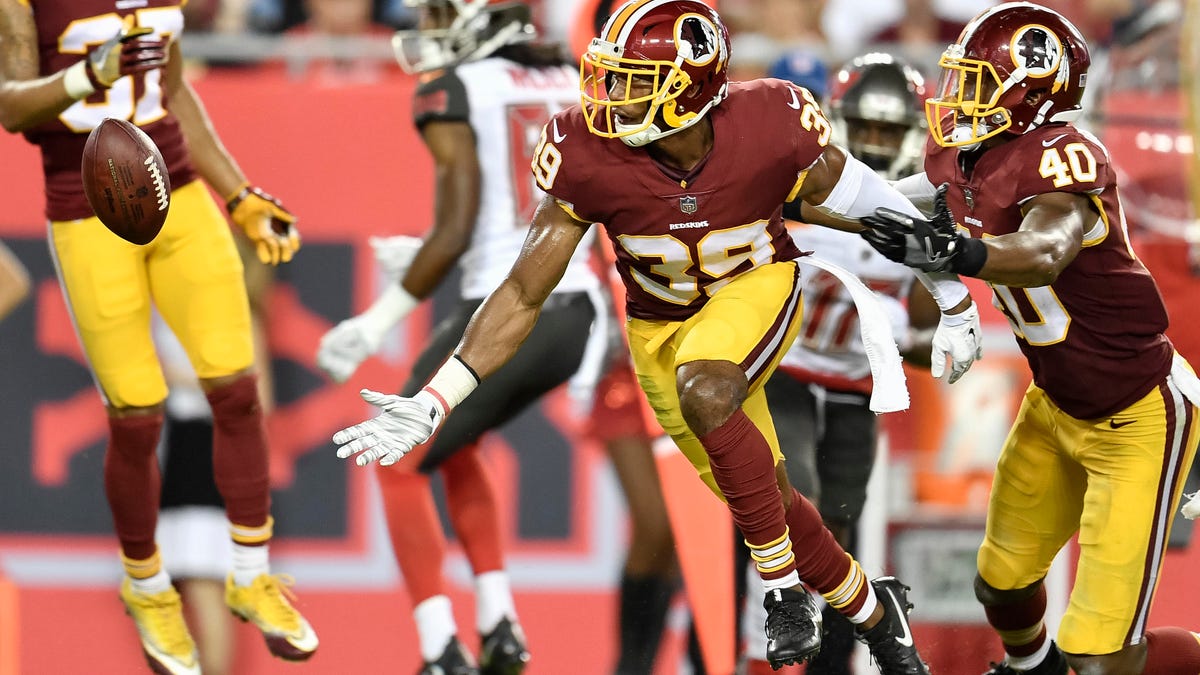How Fanatics knows what jersey you want to buy before you do
The seller of sports gear finds clues scattered across Facebook, Twitter, email and elsewhere to get a jump on who the hot players are.

Washington Redskins defensive back Stefan McClure, center, cropped up as a new potential big seller in Fanatics' analytics platform.
Two years ago, an undrafted free agent named Jarryd Hayne unexpectedly made the cut and joined the San Francisco 49ers' lineup as a running back.
Plenty of players barely survive preseason and then slide into irrelevance, but that's not what happened with Hayne. The former rugby star for the Parramatta Eels in Australia quickly found a fan base in both the US and Australia, with thousands of people clamoring to buy a replica of his jersey.
Any retailer can be prepared to stock copies of jerseys worn by superstars like New England Patriots QB Tom Brady. But Fanatics, America's biggest online sports retailer, was able to respond to the sudden surge in demand for Hayne gear. How? Over the past three years, it's quietly developed an analytics platform that crunches over 200 variables, including Twitter chatter, online advertising data, and sales stats, to figure out which players will become popular before the public catches on.
"Things happen so fast, so just the ability to react fast on the site and in an automated way" is vital, Matt Madrigal, Fanatics' chief technology officer, said in an interview just before the start of the NFL season this past Thursday.
Using this data, Fanatics rode the wave of Hayne's fandom, with the player becoming the top-seller across the Fanatics network during the start of the 2015 NFL season. (He retired after that one season, proof that seizing the moment for retailers is critical ... and also a lesson that it may be smart for fans to wait before plunking down cash on a hot new player.)
Though Fanatics' work is a little advanced in the retail world, it's a clear sign of changing customer expectations. Shoppers want what they want now, even if they're buying online, and they expect to find esoteric, personalized and customized gear just as quickly. Plenty of retailers are fulfilling this desire, using speedier shipping, better analytics, and manufacturing that's measured in days not weeks. Those sellers are more likely to build customer loyalty and avoid getting crushed by Amazon, the dominant force in e-commerce.
"Whatever customers want, they can usually have it," said Yory Wurmser, a retail analyst for eMarketer. "That's seeping into other industries and that's what's changing customer expectations."
If you've been in the market for sports gear, there's a good chance you've wound up on a Fanatics-run site. The privately owned US e-tailer has grown by developing deep relationships with every major US sports league. Along with its own sites, it now runs the online stores for the NFL, MLB, NBA, NHL, MLS, PGA and more than 200 college and pro teams. (It also runs the store for Nascar, and for media brands including CBS Sports, which is owned by CNET's parent CBS.) Fanatics expects to hit $2 billion in revenue this year, according to a report last week from Reuters.
To determine what inventory to stock and manufacture, Fanatics pulls together data including the number of searches for any given player on its websites, sales on its sites, and clicks on specific jerseys in digital ads and Fanatics' emails to fans. It even scrapes Facebook and especially Twitter to develop a "sentiment analysis," using natural language processing software, Madrigal said.
Fanatics taps that analytics info to get a jump on demand, elevating the search rankings of newly popular players on its websites and manufacturing small batches of gear for those players before customers even start to show up and click the buy button.
Using its speedy manufacturing operations, Fanatics is also working to seize on viral "micro moments" in sports, like a stunning catch from New York Giants' Odell Beckham Jr., and bank off them with T-shirts, posters and other memorabilia. The company last year even teamed up with Uber to get championship hats and T-shirts to Chicago Cubs fans minutes after they'd bought them.
Though this work can allow Fanatics to squeeze more money from each game, the company has also been able to use its fast-fashion powers for good. The company helped raise money for victims of Hurricane Harvey by creating a "Houston Strong" clothing line that included all the city's sports teams, Reuters reported. Fanatics was able to turn around the design, get permissions from teams, and start shipping in three days, according to the report.
Using its analytics tools, Fanatics this year set its sights on another new hit from the preseason: Stefan McClure, defensive back for the Washington Redskins. Reading signals from Twitter about McClure's strong performances, and increased search traffic on Fanatics.com and NFLShop.com, Fanatics had an early read on fan interest and ramped up its inventory to quickly respond, Madrigal said.
"We've gotten micro moments that happen all over the place," he said.
Goodbye, home button? Get ready for the iPhone's biggest change ever.
Apple event: What we expect at the big Sept. 12 iPhone (and more) launch.

